
Many people get small shrimp as additions to their aquariums. They buy the shrimp and throw them in a newly set up tank. The shrimp then die. Or they put the shrimp in with larger fish who eat the shrimp when the shrimp do something called “molting” (after molting the exoskeleton of the shrimp is soft and vulnerable).
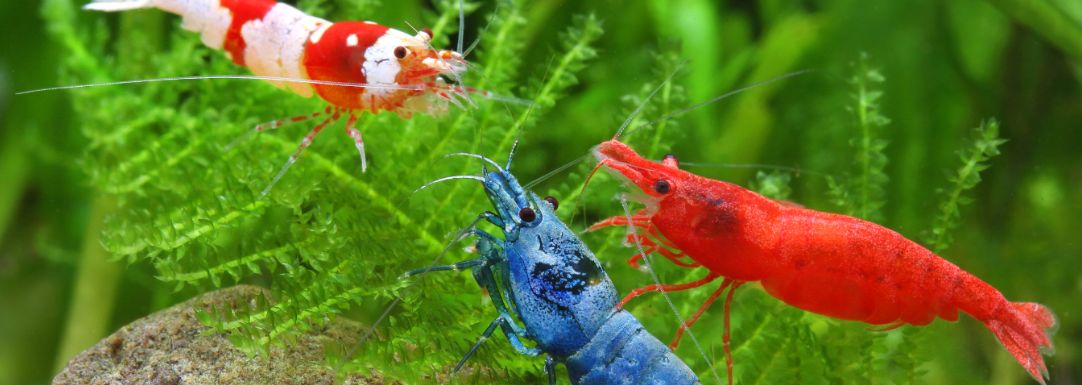
Setting up a Shrimp Aquarium
Shrimp are not for the beginner. They need a well-established tank that has a lot of algae and/or plant growth. They also need well established filters which have not been cleaned in months. They need bacteria free water. And they need careful VERY LIGHT feeding. The aquarium needs to have a healthy growth of algae in it (see the aquarium at the top of this article). The “rule” for healthy shrimp is simple:
.
Only put shrimp in an aquarium which has “matured” for at least two months
.
Shrimp do best with:
- Crystal clear, bacteria free water
- A mature filter that has a lot of brown gunk
- Lots of established plants which are thriving
- Lots of green algae (their main food source)
- Very little added food
- dGH between 3 and 15
Getting this with a planted tank typically takes six months to a year. So set up the planted tank however one wants to do it and only add the shrimp when the above conditions are met. This takes three very important things:
.
Patience, Patience and Patience
.
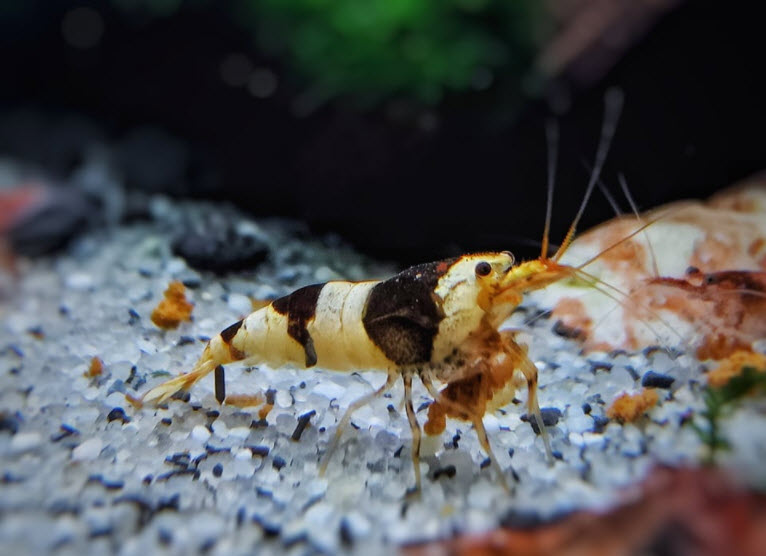
What if You Have a New Aquarium with Shrimp in It?
An exchange with a reader is pertinent here:
“Hi Dave
I need your help. I have a 20 gallon tank, I was advised to just add JBL Denitrol (“Instant Start bacteria”) and add fish. I now have 9 celestial danios, 3 snails and some shrimp, along with live plants. My nitrate and nitrite keeps spiking (no ammonia). I have a sponge filter and air stone, I feed small amounts but not sure what I should do. I do NOT want to lose my fish or treat them badly. I am using Seachem Prime and adding bacteria when changing water. After reading your articles I know I have messed up but can I salvage the situation and how? PH is at 8.0. Thank you. Becci”
“Dave
In reply to Rebecca … You are just fine. Probably 90% of the newbies to the hobby do exactly what you did. Here is what I would do. Do NOTHING other than feeding the danios a very small amount of food every day and leaving your light on for 14 hours a day (largely to deliberately grow algae for the shrimp to eat). Don’t do a water change, don’t clean any algae off of anything, don’t add “bacteria” (worthless), don’t vacuum, don’t clean the sponge filter, don’t test the water. Do NOTHING for at least three months. Just let Mother Nature do her thing.
Keep the Prime in order to remove chlorine (It ONLY removes chlorine). If the water gets cloudy or green simply ignore it and let it go. After three months start cleaning the algae off ONLY the front and side glass. The plants will probably slowly die but they will be shrimp and snail food as they die. Enjoy a glass of wine.”
This exchange explains what is required for a shrimp aquarium very well. So I’ve included it.
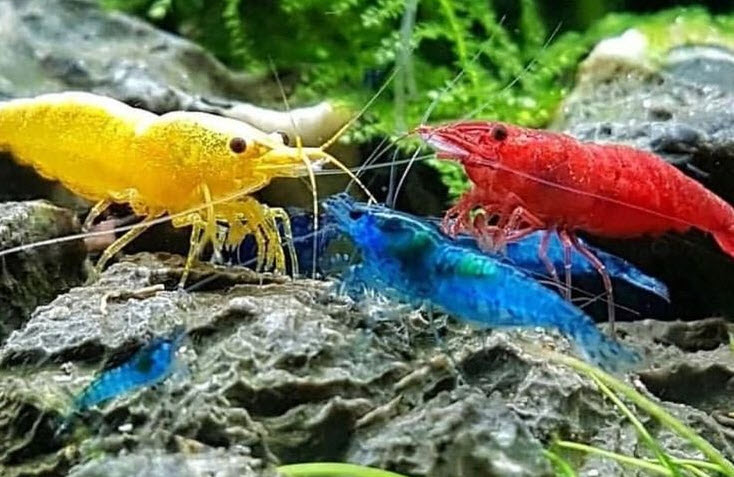
Another way to set up a shrimp aquarium is to run the tank with a few feeder goldfish in the tank for three to six months. Feed the goldfish heavily and do not clean the filter. Leave the light on 24/7. Put in some plants. Do NOT remove the algae growth from the back of the aquarium, rocks and/or decorations. This will give you a mature tank. Then, after three to six months, take the goldfish out, clean the filters VERY lightly, do a 95% to 100% water change to get nitrates below 40 ppm and add your shrimp.
There are several other ways to get a mature aquarium. This is covered in this article:
2.14. The Mature Aquarium
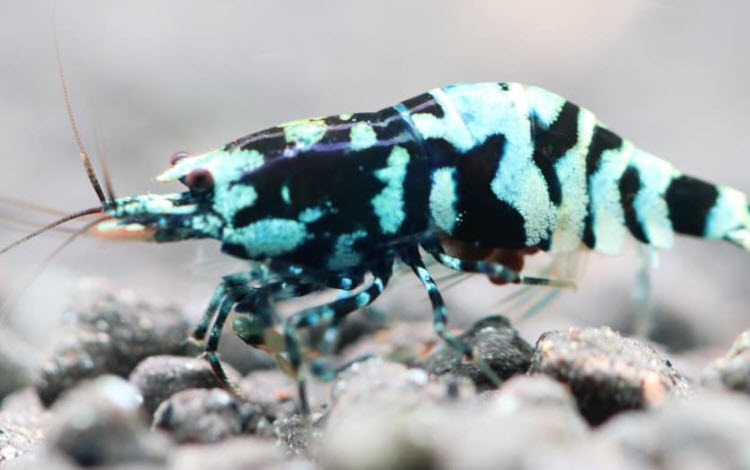
Water Quality for Shrimp
Shrimp are arthropods. Arthropods lack the efficient liver found in fish. This makes them much more susceptible to things like nitrate. Nitrate in a shrimp tank should be lower than 80 ppm and preferably less than 40 ppm. If one has a planted tank, one needs to be very careful with nitrogen fertilizers because of this sensitivity.
Ammonia should be 0.25 ppm or less and nitrite should be zero. The aquarium should have been cycled for at least two months before introducing most dwarf shrimp species. Water changes need to be sufficient to maintain at least less than 40 ppm nitrate.
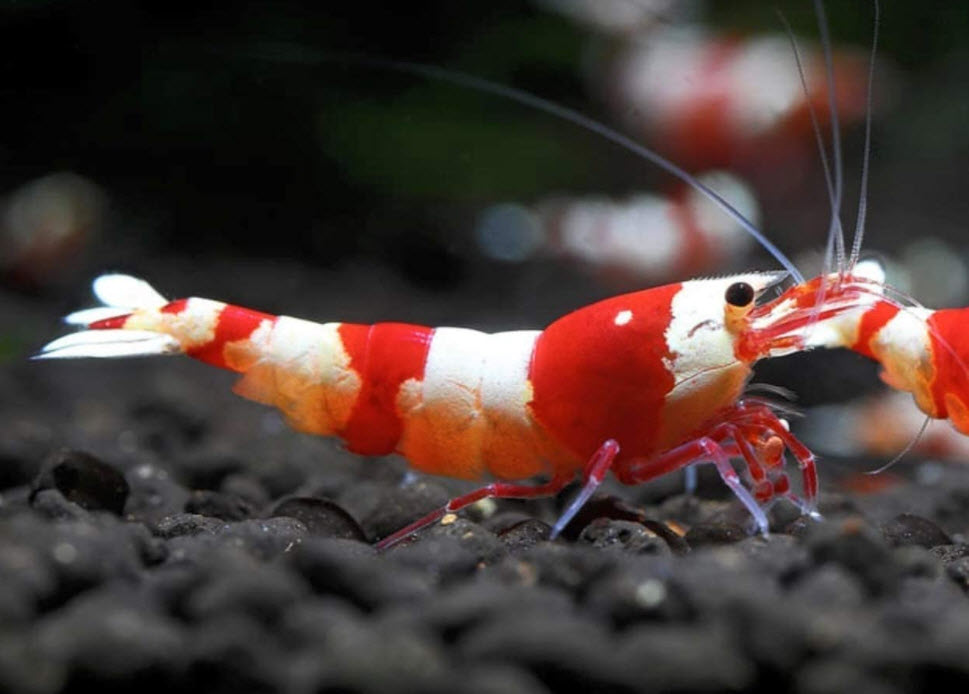
Water Parameters for Shrimp
Shrimp need some specific water parameters due to the fact that they have calcium as a reinforcing and hardening element in their shells. They need SOME calcium and magnesium but not TOO much. It all has to do with the complex process of molting. If the shrimp do not have enough calcium and magnesium the shell will not be strong and will break during molting (the infamous “white ring of death”).
The shrimp cannot get the broken shell off and dies as a result. But conversely, too much calcium and magnesium and the shell will be too strong and require very heavy exertions for the shrimp to get it off. This exertion can overstress the shrimp and kill it.
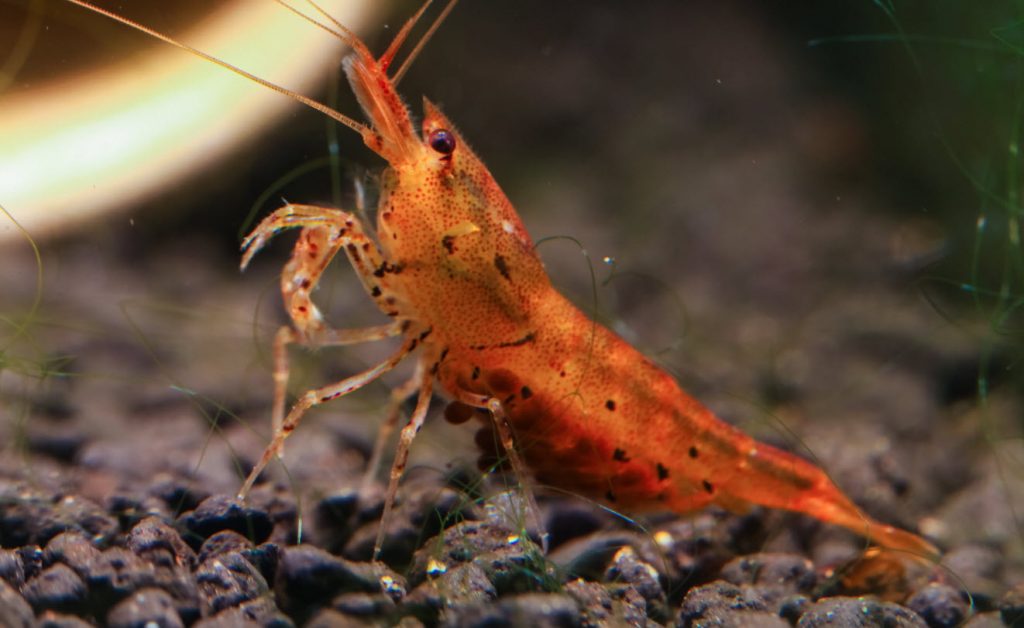
For the “optimum” one wants to add enough calcium and magnesium to take the dGH to 6. First measure the dGH of the tap water. Then, if the dGH is lower than 6, one needs to add a powder made up of Epsom salts and calcium sulfate. Add together equal quantities of Epsom salts (magnesium sulfate) and calcium sulfate.
One dGH is 18 mg/l or 18 ppm of calcium and magnesium. The salts are about half water. In 10 gallon one ppm is 0.036 grams. So for each dGH one needs to add, add (18 x 0.036)/0.5 = 1.3 grams of the 1:1 mixture per ten gallons.
So make up the mixture. Mix well. Then measure the dGH. If the dGH of the tap water is 2 then one needs to add 4 dGH to get 6 dGH. So one needs to add 4 x 1.3 or 5 grams of the salt mixture per ten gallons of water. If doing a 50% water change on a 40 gallon tank that is 20 gallons of water which will need 5 x 2 = 10 grams of the mixture. This is roughly two level teaspoons of the mixture in twenty gallons.
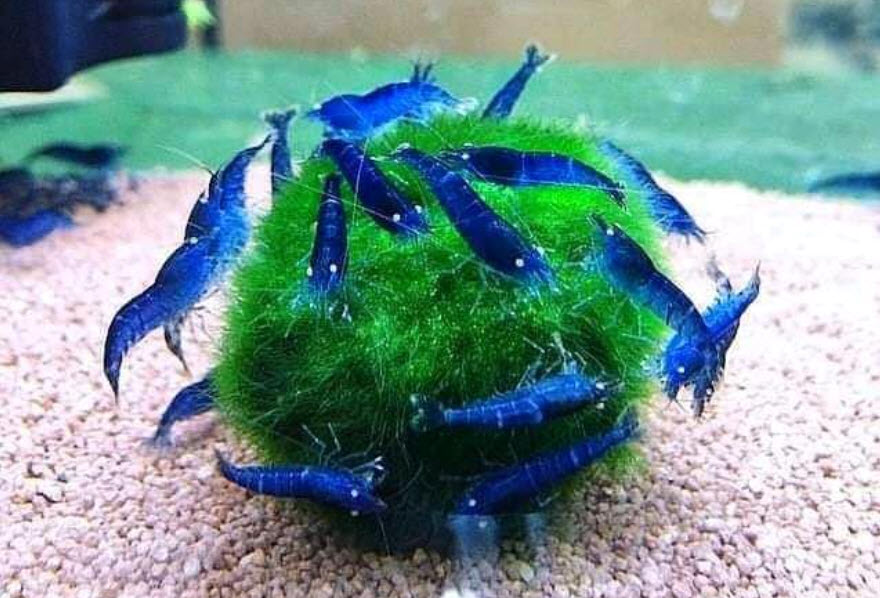
But also note this is not a “requirement”. The shrimp will be fine at any dGH between 3 and 15. The word “optimum” does not equate to the word “requirement”. Simply adding some crushed coral to the substrate seems to work very well for shrimp.
There is a lot of OPINION out there that shrimp (especially Caridina shrimp) require acidic, low pH water with no KH. But there are NO journal articles supporting this. Indeed, no less than five journal articles say aquarium Caridina shrimp do just fine at any pH from 6.5 to 8.5 (Mahmoudi, 2020; Ganesh 2015; Ariyanathan, 2016; Heerbrandt, 2006; Barbier, 2010). Caridina shrimp are found in limestone areas of Taiwan, Philippines and Indonesia where the pH is between 7.5 and 8.8 and the KH is 10 to 20 (Chiao-Chuan Han 2011). I have bred Caridina shrimp in my South Florida well water with a dKH of 12 and a pH of 8.2. So I have to say this is a myth.

Feeding Shrimp
The food requirements of shrimp are very misunderstood. Shrimp have a MUCH lower metabolism than fish. While they will attack a food pellet eagerly, they will not eat very much of it. Uneaten food will breed bacteria in the aquarium water column. And bacteria in the water column can kill the shrimp. Shrimp often do better with no feeding at all. They just eat the green algae that forms in any well lit aquarium.
We do not recommend feeding shrimp commercial food in the form of pellets or flakes. Rather once a week (and ONLY once a week) put in a small piece of fish filet or a small edible shrimp that is tethered. The tether can be a string tightly tied to the food or simply a fork impaling the food. Leave the food in the tank for 12 hours hours. Then remove the uneaten portion. Vegetables such as zucchini can be given the same treatment. In this way there is no uneaten food in the tank which can produce problems.
Alternatively if one has a lot of shrimp on can just feed one pellet of fish food per week. Remember, the main food source for aquarium shrimp is green algae. Provide lots of green algae in the tank and your shrimp will typically prosper.

Shrimp require mature aquariums with lots of algae and/or plants as they are natural food sources for the shrimp. Never place shrimp in a newly set up aquarium! And never clean the algae off the ornaments or plants. Just clean the algae off the front glass of the aquarium. Use a good light source with both crimson and deep blue LEDs to grow lots of algae and/or plants. Keep the lights on for at least 8 hours a day. This will give the shrimp material to feed on all day long.
Adding a small piece of a dried brown leaf once a week or so feeds the shrimp in an interesting indirect way. The leaf decomposes slowly, releasing carbohydrates. Water molds feed on the carbohydrates. And shrimp eat the water molds. So leaves, IN SMALL AMOUNTS, are beneficial in a shrimp tank. These leaves can be of any variety, they do not need to be Indian Almond leaves.
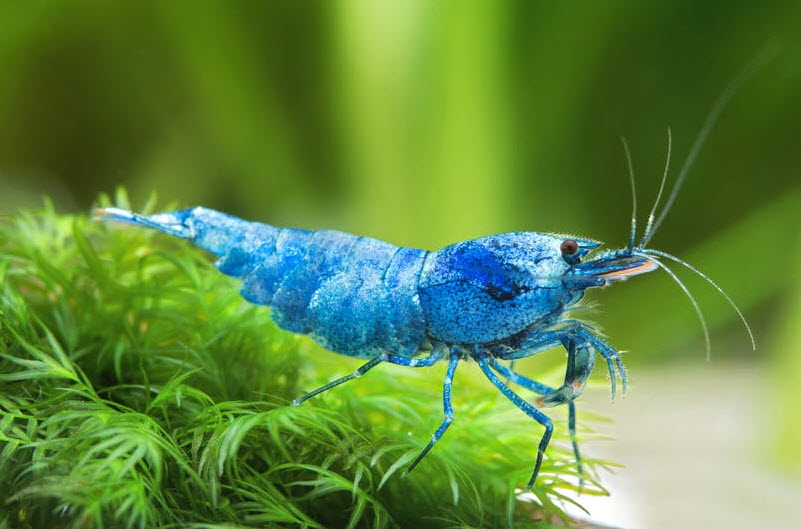
Filtration for Aquarium Shrimp
Shrimp are best kept with air driven sponge filters or air driven undergravel filters. They can be easily sucked into the intake of more powerful filters. And water pumps will tear up baby shrimp when the shrimp pass through the pump. While air driven filters are not as efficient as pump driven filters, properly fed shrimp should give a very low bioload. So pumped filters typically aren’t required.
We recommend the sponge filters made by Aquarium Co-op as they are a very well thought out design. The sponge filters should only be rarely cleaned, like a very light swishing in a bucket of water once every three months. DO NOT put sponge filters under running water, even if it is unchlorinated well water. Tests show running water will clean out too much beneficial bacteria from a filter.
Air driven under-gravel filters are an excellent option with shrimp. Ultimately there will invariably be a breeding population under the filter plates but that is simply fine, they are in no danger there and they will constantly repopulate the tank above the gravel. If an under-gravel filter is just left alone with no vacuuming or cleaning it is a great filter. If it is constantly cleaned it not only does not work, but it is also a pain in the butt.
Aeration is important to shrimp. Do not use a small cheap aquarium air pump for even a small tank. Get a bigger air pump that can run two airstones. The small air pumps just don’t hack it as far as aeration goes. Note that most plants do not do well with lots of aeration. Anubias, Amazon sword, Java moss and Java fern seem to be exceptions to this “rule”. But algae do well with lots of aeration and shrimp love algae.

Compatibility
Dwarf freshwater shrimp are relatively small, so they are vulnerable to predation by larger fish. Even small cichlids like rams can decimate a shrimp population. Most shrimp enthusiasts set up dedicated shrimp aquariums with no fish at all. However, shrimp can be kept with small, non-aggressive, non-predatory fish.
Good tank mates include schools of six or more Daisy’s blue ricefish, white cloud mountain minnows, otocinclus, pygmy corydoras, Celestichthys margaritatus (“celestial pearl danio” or “galaxy rasbora”), glowlight tetra, dwarf pencilfish, various small danios, small barbs such as ruby, and cherry, and small rasboras such as emerald, dwarf, lampeye, chili, phoenix, somphong, galaxy and pygmy. A school of green kubotai rasbora is stunning!
Jut be aware that these fish, while they cannot eat the adult shrimp, these small fish will eat the tiny baby shrimp. So one typically cannot breed lots of shrimp in an aquarium with even small fish in it. There is one exception. If the tank is heavily planted, most of the shrimp babies can successfully hide from the fish till they are grown. Masses of Java moss are great for breeding shrimp with small fish. Breeding shrimp can also be kept with snails.

Breeding Shrimp
Shrimp only live about one year (there are exceptions to this), so we do recommend establishing a breeding colony. To do this one should purchase at least ten shrimp initially. In order to breed shrimp one must avoid combining different colors of shrimp in the same aquarium. A tank with red shrimp and blue shrimp mixed will breed a bunch of dull brown or clear shrimp.
Note that the genus neocaridina shrimp do not breed with the genus caridina shrimp. The color range of both genus is now very similar. So it is possible to have bright red neocaridina shrimp in with bright blue caridina shrimp and one will not get cross breeding. But note most breeders don’t know if they have caridina or neocaridina so it will take some sleuthing to set up a mixed tank.
Most shrimp breed readily in captivity, however, success varies from species to species. Red cherry shrimp and certain other Neocaridina, for example, can quickly develop into large colonies in tanks with no fish and lots of algae. Ten red cherry shrimp can become literally hundreds in even a small aquarium in one year. The result can be mesmerizing.

Other Tank “Visitors”
And be aware of one “problem” with breeding shrimp. In a fishless shrimp tank, all sorts of little organisms will colonize the tank. There will be hundreds of little white specks scooting around. These are tiny crustaceans such as water fleas and cyclops. There will also typically be rhabdocoela flatworms and annelid detritus worms crawling around through the substrate. It is all just Mother Nature at work. Adding more biofiltration can control these critters somewhat but you will always have a few of them in any fishless tank.
Shrimp colonies can get some unwelcome visitors. Watch out for “worms” that are brown and one quarter to one inch long. These can be either dugesia planaria (very slow moving and flat) or Asian freshwater leeches (faster moving and round). Both these predators can wipe out a colony of shrimp in short order.
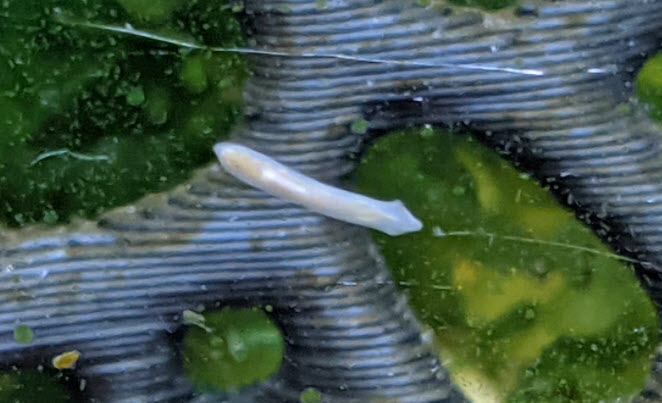
Planaria and Leeches
Planaria are a common predators of shrimp. These small gliding flatworms come out at night and paralyze and eat baby shrimp and even shrimp much larger than they are. They are very common denizens in the roots of aquarium plants as they come in the pet store. Because of this I recommend treating any set-up aquarium with fenbendazole or praziquantel for at least four weeks before adding shrimp. With fenbendazole be sure to wait at least a week after any treatment as fenbendazole can kill shrimp. Praziquantel is safer but less effective.
Then treat any new plants with fenbendazole or praziquantel in a quarantine tank for four weeks before adding them to a shrimp tank. Believe me when I say you do not want planaria in your shrimp tank. Because these planaria come out at night it is common for the shrimp in a tank to just not be successful reproducing. The unseen planaria are eating all the babies.
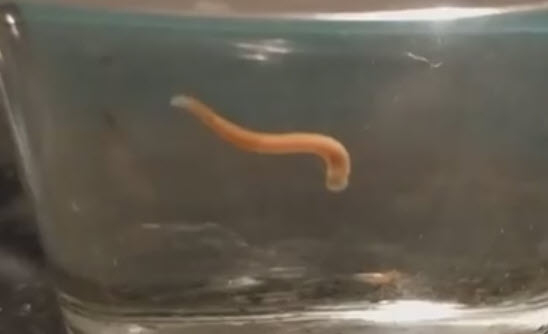
Another predator is the Asian leech. Leeches do not glide, rather they move rapidly by expansion and contraction movements. Leeches can decimate a shrimp colony and are more difficult to eliminate than planaria.
For more on these topics go to these links:
10.13.3. Planaria in the Aquarium
10.13.4. Aquarium Leeches
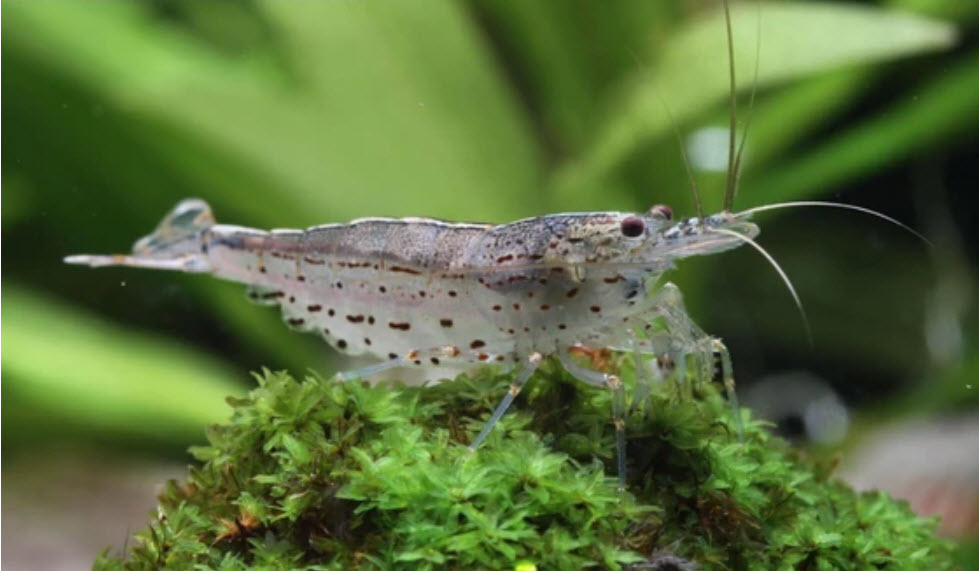
Copper Poisoning
Another problem seen occasionally is copper poisoning. Most homes have copper plumbing on the tap water. Certain water chemistries (soft water, salty water, or acid water) can erode significant amounts of copper as the water sits in the copper pipes. Copper is very poisonous to shrimp. So if one has soft water, salty water, or acid water, it is best to leave the water flowing for one minute or so before using the water in the shrimp tank. This will avoid the possibility of copper poisoning.
But note that the copper found in fish food is in far too small a quantity to be a concern. Copper is needed in VERY tiny amounts by fish.
.
Return to Fish Selection Menu
.
Aquarium Science Website
The chapters shown below or on the right side in maroon lead to close to 400 articles on all aspects of keeping a freshwater aquarium. These articles have NO links to profit making sites and are thus unbiased in their recommendations, unlike all the for-profit sites you will find with Google. Bookmark and browse!
.

Mike says
Hi Dave , I also run a 3watt uv sterilizer in my 20gallon aquarium . My question is will it have any effect on things like biofilm and such that shrimp specifically baby shrimp eat?
Mike says
Thank you for the response on temp for my shrimp. I was somewhat concerned it may be too warm for them. I have amono shrimp with them as well. My question is your thoughts on bacter ae. Is that something that would be beneficial to the shrimp or is what the fish miss be sufficient for them. Once again my Google searches are all over the place
Dave says
In reply to Mike Temperature shouldn’t be a problem. If shrimp start disappearing I take a long hard look at the bristle nose
Mike says
Hi Dave I’ve recently added amono and blue dream shrimp to my aquarium. I live in Hawaii my tanks temp fluctuates from 78 up to 82 threw out the day will those temps be harmful to my shrimp? I also have neon’s, black neon tetras and a bristle nose plecco in my tank. I’ve searched Google and the answers are all over the place.
Dave says
In reply to Dan …. A 50:50 mix of softened and hard water would probably be about the optimum for shrimp.
Dan says
Thoughts on using water treated by a Softener aka Culligan. Our tap water is incredibly hard and wasn’t sure to use that or the treated water. Which would better for shrimp?
Thanks in advance.
Kristine says
Have any information on cladogonium ogishimae? Just noticed it on one cherry shrimp, and the Internet doesn’t seem to have a ton of information on it.
Hellen says
Any recommendation to promote algae grow effectively? Light or else? Thabks
Dave says
In reply to Peter ….. Add the mineral block. Shrimp do better with some hardness in the water.
Peter says
Hi dave,
If fish don’t drink, do shrimp behave the same way? If so, does that mean providing mineral supplements to the aquarium water is ineffective? Or should we add mineral supplements to their food instead?
I am considering adding a mineral block typically used for turtles. What do you think, would it pose any problems?
Dave says
In reply to Tyler …. Yes it applies to both shrimp and crayfish.
Tyler says
I assume it does, but does this apply to crayfish as well?
Dave says
In reply to anonymous ….. Sorry, there is no magic bullet for that. Fenbendazole will kill all three pests but it also has an annoying habit of killing shrimp. You might try guppies. They will get some of the baby shrimp but they also eat the pests.
Anonymous says
Planaria, hydra and asian leech. Or do you have any recommend to kill all the shrimp pest in with the shrimp in the tank? Sort of sterilization method but with the shrimp already in tank.
Dave says
In reply to Benta …. Which shrimp pest?
Benta says
How to treat shrimp pest with the shrimp in the tank?
Dave says
In reply to Mikey …. It is just fine for shrimp.
Mikey says
Hi Dave, what if my tap water hardness is 300ppm do i need treat my water first? Or it will do just fine for keeping and breedinf shrimp. Thanks